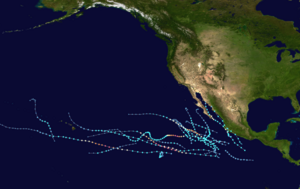
Back Pazifische Hurrikansaison 2019 German Temporada de huracanes en el Pacífico de 2019 Spanish 2019년 동태평양 허리케인 Korean Temporada de furacões no Pacífico de 2019 Portuguese ฤดูพายุเฮอริเคนแปซิฟิก พ.ศ. 2562 Thai Mùa bão Đông Bắc Thái Bình Dương 2019 Vietnamese 2019年太平洋颶風季 Chinese
| 2019 Pacific hurricane season | |
|---|---|
 Season summary map | |
| Seasonal boundaries | |
| First system formed | June 25, 2019 |
| Last system dissipated | November 18, 2019 |
| Strongest storm | |
| Name | Barbara |
| • Maximum winds | 155 mph (250 km/h) (1-minute sustained) |
| • Lowest pressure | 930 mbar (hPa; 27.46 inHg) |
| Seasonal statistics | |
| Total depressions | 21 |
| Total storms | 19 |
| Hurricanes | 7 |
| Major hurricanes (Cat. 3+) | 4 |
| Total fatalities | 12 total |
| Total damage | > $65.2 million (2019 USD) |
| Related articles | |
The 2019 Pacific hurricane season was an above average season which produced nineteen named storms, most of which were rather weak and short-lived.[nb 1] Only seven hurricanes formed, the fewest since 2010.[nb 2] The season officially began on May 15 in the East Pacific Ocean, and on June 1 in the Central Pacific; they both ended on November 30. These dates conventionally delimit the period of each year when most tropical cyclones form in the Pacific basin. This season was one of the latest-starting Pacific hurricane seasons on record (reliable records began in 1971), with the first tropical cyclone, Hurricane Alvin, forming on June 25.[2] The final system, Tropical Depression Twenty-One-E, dissipated on November 18.
The season had a rather slow start, with no cyclones forming in the basin before the month of June for the first time since 2011. The strongest hurricane of the season, Barbara, formed on June 30 and peaked as a high-end Category 4 hurricane on July 3. August was extremely quiet with no hurricanes forming during the month, a first for a season since 1973. September was much more active with six systems developing, of which three became hurricanes. Activity decreased appreciably in October and November as most of the storms remained weak and short-lived.
Land impact was relatively minor for most of the season. The remnants of Barbara caused power outages in Hawaii in early July. Hurricanes Erick and Flossie both threatened Hawaii, but the systems weakened significantly before reaching the islands, both causing minimal effects. Tropical Storm Ivo caused intense flooding while it remained offshore of Mexico. In late September, Hurricane Lorena made landfall in southwestern Mexico and Baja California Sur, and its remnant moisture entered the southwestern United States. Lorena was responsible for one death and damages worth $50 million (2019 USD).[nb 3] Tropical Storm Narda took a nearly identical track a week later, killing six and causing $15.2 million in damage. Overall, this season was drastically less active and destructive than the previous year, causing about $65.2 million in damages and seven fatalities.
- ^ a b Cite error: The named reference
EPAC HURDATwas invoked but never defined (see the help page). - ^ "Eastern Pacific's First Storm of Hurricane Season May Develop This Week at an Unusually Late Date". The Weather Channel. Retrieved 6 August 2019.
Cite error: There are <ref group=nb> tags on this page, but the references will not show without a {{reflist|group=nb}} template (see the help page).